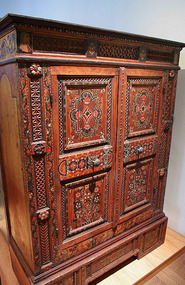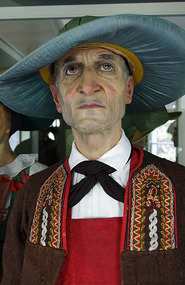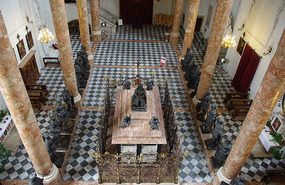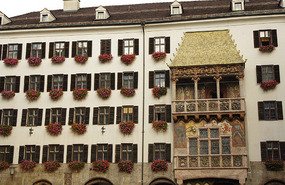It was a cloudy and cool day outside so it was perfect for a visit to the Tyrolean Folk Museum. We drove into Innsbruck and parked a bit outside town and then walked to the museum. The museum was one of the best museums that I've ever been to in terms of the quality and variety of exhibits, layout of museum, english guide and value for money. We ended up spending nearly four hours there despite glossing over many of the exhibits. Once we got started, we were just lured from one exhibit to the next. It was the type of museum that you’d get a yearly pass to and still have lots to see every time you went.
The electronic guide was very informative and interactive. You just had to scan the exhibit you were looking at and it pulled up the relevant information and often provided additional photographs or background information. On a high level, the museum covered the various aspects of daily life of the people of Tyrol with a lot of it focused on the domestic and cultural aspects. I won’t go into the details of each of the exhibit but here are some of our highlights:
- Woodworking tools and furniture: intricately decorated planes, chisels, hand drills and other tools which in turn were used to produce amazing furniture including beautifully carved cabinets, chests with hidden compartments, chairs and stools
· Farm life: an impressive array of decorative butter molds, animal bells including beautifully carved goat yokes, butter churns and milking stools, and flour chests. Flour was stored in a chest and the owner would smooth out the top layer and then make and indentation with a stamp. This served to identify the owner and also if it was disturbed, he would know that someone had stolen from it!
· The life-size parlours or "stubes" from the 15th century onwards. Many of them are original parlours that the museum purchased, took apart and then carefully reconstructed to give you the exact look and feel of the room. You can walk through about ten different parlours and even sit on the furniture. The only thing missing was a roaring fire, some hot food and cold beer being served.
·
Traditional folk costumes on life-like wood figures (it almost felt like you were in a wax museum): when the museum creators had thought about wanting to capture the traditional garb of the various peoples of the Tyrol area, they commissioned a sculptor to carve life size models on which the clothes could be displayed. The sculptor sought out real people from each area, sketched them, and then carved life-size figures in their exact image!
· Old photography exhibit: recreated a typical photo studio from the early days of photography with actual photographic equipment from the time including flashes, shades, cameras, negative plates
Our visit to the museum also included a visit to the neighbouring church which is famous for the imperial tomb of Emperor Maximilian I, a member of the Habsburg family (a family that we’d continue to learn about at various other museums). Before we entered the church, there was an amazing multimedia display that gave us a background on the emperor, his dynasty and also his fascination with wanting to be remembered both in life and in death. So to ensure the latter, he spent an absolute fortune building his imperial tomb where he wanted to be buried. Maximillian I didn’t control his finances very well during his reign and ran up quite a debt.
His tomb was also only partially complete at the time. When he died, the Austrian parliament denied him his wish to be buried in his tomb. I felt that this was very socially responsible of the Austrians. However, they couldn’t stop future monarchs from continuing to pour money into to completing the tomb. I wonder if they’re still trying to recoup the costs today using our entrance fees. The tomb takes center stage in a large church and is flanked on either side by life size statues of people that the emperor admired, including King Arthur. Not a very humble emperor, he also included a statue of himself. The tomb itself is about 3 meters high, by 2 meters wide by about 7-8 meters long. It is made mostly out of marble and inlaid with intricate carvings of scenes from the emperor’s life. The iron grill work surrounding the tomb is really impressive, too.
Once we were done visiting the tomb, we stopped off in the museum for a café since we were both pretty tired having walked non-stop for nearly four hours. From there, we wandered through a few of the main streets of the old town of Innsbruck and took some pictures of the neat building facades and of the famous Golden Roof.
This roof, finished with gold colored tiles, was built by Maximillian I so he had a place in the center of town from which to watch over festivities and celebrations. Having explored the town a bit, we also picked up a sacher torte and apfelstrudel for desert back at camp. Sacher tortes, a regional specialty, are a soft, dry chocolate cake topped with a layer of chocolate. Both desserts were really delicious and I’m slowly coming to the conclusion that there is no such thing as a bad patisserie in Europe – there is only good, excellent, and mouth-watering.
Innsbruck
Sunday, October 14, 2012
 Innsbruck, Austrian Alps, Austria
Innsbruck, Austrian Alps, Austria
Other Entries
-
36Col d'Izoard
Sep 1529 days prior Briançon, Francephoto_camera37videocam 0comment 6
Briançon, Francephoto_camera37videocam 0comment 6 -
37Briançon
Sep 1628 days prior Briançon, Francephoto_camera30videocam 0comment 3
Briançon, Francephoto_camera30videocam 0comment 3 -
38Mont Ventoux
Sep 1826 days prior Malaucene, Francephoto_camera47videocam 0comment 1
Malaucene, Francephoto_camera47videocam 0comment 1 -
39Escargots & Grenouilles
Sep 1925 days prior Pont en Royans, Francephoto_camera44videocam 0comment 4
Pont en Royans, Francephoto_camera44videocam 0comment 4 -
40Choranche Caves
Sep 2024 days prior Pont en Royans, Francephoto_camera30videocam 0comment 3
Pont en Royans, Francephoto_camera30videocam 0comment 3 -
41Cinque Terre
Sep 2222 days prior Levanto, Italyphoto_camera55videocam 0comment 2
Levanto, Italyphoto_camera55videocam 0comment 2 -
42Venice
Sep 2519 days prior Venice, Italyphoto_camera96videocam 0comment 6
Venice, Italyphoto_camera96videocam 0comment 6 -
43Forni di Sopra, a quick visit
Sep 2618 days prior Forni di Sopra, Italyphoto_camera16videocam 0comment 0
Forni di Sopra, Italyphoto_camera16videocam 0comment 0 -
44Davos
Sep 3014 days prior Davos, Switzerlandphoto_camera46videocam 1comment 1
Davos, Switzerlandphoto_camera46videocam 1comment 1 -
45Schilthorn and North face walk
Oct 0212 days prior Lauterbrunnen, Switzerlandphoto_camera56videocam 3comment 5
Lauterbrunnen, Switzerlandphoto_camera56videocam 3comment 5 -
46To the "Top of Europe"
Oct 0311 days prior Lauterbrunnen, Switzerlandphoto_camera76videocam 5comment 7
Lauterbrunnen, Switzerlandphoto_camera76videocam 5comment 7 -
47The Rothorn and Schynige Platte
Oct 059 days prior Lauterbrunnen, Switzerlandphoto_camera73videocam 0comment 2
Lauterbrunnen, Switzerlandphoto_camera73videocam 0comment 2 -
48Mannlichen and First
Oct 068 days prior Lauterbrunnen, Switzerlandphoto_camera39videocam 0comment 1
Lauterbrunnen, Switzerlandphoto_camera39videocam 0comment 1 -
49Castles in Bavaria
Oct 086 days prior Füssen, Germanyphoto_camera47videocam 1comment 2
Füssen, Germanyphoto_camera47videocam 1comment 2 -
50Linderhof Palace & Rococo churches
Oct 104 days prior Linderhof, Germanyphoto_camera39videocam 0comment 4
Linderhof, Germanyphoto_camera39videocam 0comment 4 -
51Munich
Oct 122 days prior Munich, Germanyphoto_camera157videocam 0comment 5
Munich, Germanyphoto_camera157videocam 0comment 5 -
52Herrenchiemsee palace
Oct 131 day prior Herrnchiemsee, Germanyphoto_camera9videocam 0comment 1
Herrnchiemsee, Germanyphoto_camera9videocam 0comment 1 -
53Innsbruck
Oct 14 Innsbruck, Austriaphoto_camera85videocam 0comment 7
Innsbruck, Austriaphoto_camera85videocam 0comment 7 -
54Return to Forni di Sopra
Oct 217 days later Forni di Sopra, Italyphoto_camera24videocam 0comment 5
Forni di Sopra, Italyphoto_camera24videocam 0comment 5 -
55Berchtesgaden
Oct 239 days later Berchtesgaden, Germanyphoto_camera18videocam 0comment 1
Berchtesgaden, Germanyphoto_camera18videocam 0comment 1 -
56Salzburg
Oct 2410 days later Salzburg, Austriaphoto_camera48videocam 0comment 0
Salzburg, Austriaphoto_camera48videocam 0comment 0 -
57Hallstatt
Oct 2511 days later Hallstatt, Austriaphoto_camera37videocam 0comment 3
Hallstatt, Austriaphoto_camera37videocam 0comment 3 -
58Mauthausen Concentration Camp
Oct 2612 days later Mauthausen, Austriaphoto_camera22videocam 0comment 1
Mauthausen, Austriaphoto_camera22videocam 0comment 1 -
59Melk Abbey
Oct 2713 days later Melk, Austriaphoto_camera66videocam 0comment 1
Melk, Austriaphoto_camera66videocam 0comment 1 -
60Vienna
Oct 3117 days later Vienna, Austriaphoto_camera133videocam 0comment 1
Vienna, Austriaphoto_camera133videocam 0comment 1 -
61Telc & Trebon
Nov 0219 days later Telc, Czech Republicphoto_camera23videocam 0comment 1
Telc, Czech Republicphoto_camera23videocam 0comment 1 -
62Cesky Krumlov
Nov 0320 days later Cesky Krumlov, Czech Republicphoto_camera25videocam 0comment 1
Cesky Krumlov, Czech Republicphoto_camera25videocam 0comment 1 -
63Prague
Nov 0623 days later Prague, Czech Republicphoto_camera83videocam 2comment 4
Prague, Czech Republicphoto_camera83videocam 2comment 4 -
64Kutna Hora and Terezin Ghetto
Nov 0724 days later Terezin, Czech Republicphoto_camera33videocam 0comment 3
Terezin, Czech Republicphoto_camera33videocam 0comment 3 -
65Christmas Town of Seiffen
Nov 0926 days later Seiffen, Germanyphoto_camera49videocam 0comment 5
Seiffen, Germanyphoto_camera49videocam 0comment 5 -
66Nazi Party Rally Grounds in Nuremberg
Nov 1128 days later Nuremberg, Germanyphoto_camera21videocam 0comment 1
Nuremberg, Germanyphoto_camera21videocam 0comment 1 -
67Rothenburg
Nov 1229 days later Rothenburg ob der Tauber, Germanyphoto_camera50videocam 0comment 1
Rothenburg ob der Tauber, Germanyphoto_camera50videocam 0comment 1 -
68Planes, Trains and Automobiles
Nov 1431 days later Mulhouse, Francephoto_camera34videocam 0comment 6
Mulhouse, Francephoto_camera34videocam 0comment 6 -
69Beaune
Nov 1532 days later Beaune, Francephoto_camera60videocam 0comment 7
Beaune, Francephoto_camera60videocam 0comment 7 -
70Royan
Nov 1936 days later Royan, Francephoto_camera9videocam 0comment 4
Royan, Francephoto_camera9videocam 0comment 4 -
71A second visit to London
Nov 2542 days later London, United Kingdomphoto_camera93videocam 0comment 15
London, United Kingdomphoto_camera93videocam 0comment 15

 Innsbruck, Austrian Alps, Austria
Innsbruck, Austrian Alps, Austria



























































































2025-05-22